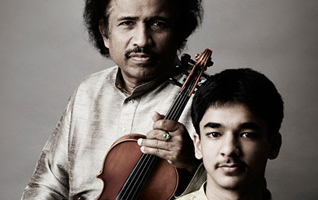by Alexandra A. Vago

The evening was filled with virtuosic playing and command of the instrument. Subramaniam has an uncanny ability to improvise with complex and intricate patterns infused with an intensely rich color palette of sound. It is no wonder why he is often referred to as “the Paganini of Indian Classical music.”
To set the mood, upon entering the auditorium, the audience was visually drawn into Indian culture with a slideshow featuring highlights from the Museum’s permanent collection of Indian and Southeast Asian Art that will open in December 2013. The stage, an elevated platform covered with carpets provided by Larchmere Oriental Rugs, was sparse.
The soft-spoken L. Subramaniam welcomed the audience and expressed his pleasure in returning to Cleveland. He gave the audience an overview of the program and briefly explained the concept of a raga (scale) and the use of microtones, ornamentation and slides.
The visual image that one often uses to describe a raga is the unfolding of petals of a mystic flower – you can think of a time-lapse video of a flower blooming, but in real time. The focus is not on harmonic structures, but rather the intricate unfurling and development of melody and rhythm over time. It is not for those who desire instant gratification – the enjoyment comes from a quasi-synesthetic experience.
The program was an exquisite presentation of Carnatic music illustrating the oral tradition relationship between guru (father) and disciple (son) replete with pyrotechnic violin playing. Both father and son combined extended techniques from the Western violin tradition and applied them to the South Indian Classical tradition. Some of their new exploits included left hand pizzicato, tremolo, ponticello, sautillé – and a right-hand bow/pizzicato effect done in the lower half of the bow that created a curious effect of tuned percussiveness.
From conversations during the brief intermission, it sounded as if members of the Indian community received little notice about this concert, yet, it was obvious that those who did attend were extremely appreciative and knowledgeable of L. Subramaniam’s accomplishments and musical prowess. Several audience members kept tal (time) with the music through a series of handclaps and waves depending upon the meter – a telltale sign of being thoroughly engaged in the musical moment.
It was patently clear that a few audience members had not heard South Indian classical music before — I overheard rumblings about intonation. Quite to the contrary, the intonation was impeccable and, my hat goes off to Rick Galbraith, the sound engineer, who crafted incomparable balance between the electronic sruti box (in place of the Tambura, a drone instrument) and the acoustic instruments.
Massoud Saidpour, the Curator of Performing Arts and Music at the Cleveland Museum of Art warmly welcomed the audience and explained this year’s focus on four themes: Masters of the Violin; Flamenco Festival; Asian Performances – Part One: Subcontinent of India; and Mother & Child.
Judging from the enthusiasm at this first concert, this thematic approach may garner a fresh and renewed interest in the Performing Arts Series – allowing the audience to immerse themselves and experience something familiar – the violin – in new and diverse ways.
For the next event in the series, the Cleveland Institute of Music and CMA will co-present the O’Connor String Quartet on Wednesday, October 30, 2013 at 7:30 p.m. in Gartner Auditorium.
Published on ClevelandClassical.com October 8, 2013
Click here for a printable version of this article.



